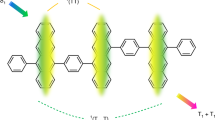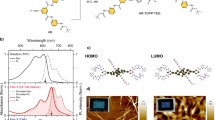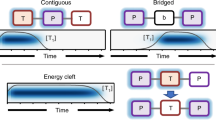Abstract
Molecules that undergo singlet fission, converting singlet excitons into pairs of triplet excitons, have potential as photovoltaic materials. The possible advantages of endothermic singlet fission (enhanced use of photon energy and larger triplet energies for coupling with common absorbers) motivated us to assess the role of exciton delocalization in the activation of this process. Here we report the synthesis of a series of linear perylene oligomers that undergo endothermic singlet fission and have endothermicities in the range 5–10 kBT at room temperature in solution. We study these compounds using transient spectroscopy and modelling to unravel the singlet and triplet dynamics. We show that the minimal number of coupled chromophores needed to undergo endothermic singlet fission is three, which provides sufficient statistical space for triplet excitons to separate and avoid annihilation—and a subsequent fast return to the singlet state. Our data additionally suggest that torsional motion of chromophores about the molecular axis following triplet-pair separation contributes to the increase in entropy, thus lengthening the triplet lifetime in longer oligomers.

This is a preview of subscription content, access via your institution
Access options
Access Nature and 54 other Nature Portfolio journals
Get Nature+, our best-value online-access subscription
$29.99 / 30 days
cancel any time
Subscribe to this journal
Receive 12 print issues and online access
$259.00 per year
only $21.58 per issue
Buy this article
- Purchase on Springer Link
- Instant access to full article PDF
Prices may be subject to local taxes which are calculated during checkout






Similar content being viewed by others
Data availability
The datasets generated and analysed during the current study are available from the corresponding author on reasonable request.
References
Schrauben, J. N. et al. Photocurrent enhanced by singlet fission in a dye-sensitized solar cell. ACS Appl. Mater. Interfaces 7, 2286–2293 (2015).
Smith, M. B. & Michl, J. Singlet fission. Chem. Rev. 110, 6891–6936 (2010).
Smith, M. B. & Michl, J. Recent advances in singlet fission. Annu. Rev. Phys. Chem. 64, 361–386 (2013).
Tayebjee, M. J. Y., Mahboubi Soufiani, A. & Conibeer, G. J. Semi-empirical limiting efficiency of singlet-fission-capable polyacene/inorganic hybrid solar cells. J. Phys. Chem. C 118, 2298–2305 (2014).
Kunzmann, A. et al. Singlet fission for photovoltaics with 130% injection efficiency. Angew. Chem. Int. Ed. 57, 10742–10747 (2018).
Congreve, D. N. et al. External quantum efficiency above 100% in a singlet-exciton-fission-based organic photovoltaic cell. Science 340, 334–337 (2013).
Tayebjee, M. J. Y., Gray-Weale, A. A. & Schmidt, T. W. Thermodynamic limit of exciton fission solar cell efficiency. J. Phys. Chem. Lett. 3, 2749–2754 (2012).
Hanna, M. C. & Nozik, A. J. Solar conversion efficiency of photovoltaic and photoelectrolysis cells with carrier multiplication absorbers. J. Appl. Phys. 100, 074510 (2006).
Jadhav, P. J., Mohanty, A., Sussman, J., Lee, J. & Baldo, M. A. Singlet exciton fission in nanostructured organic solar cells. Nano Lett. 11, 1495–1498 (2011).
Futscher, M. H., Rao, A. & Ehrler, B. The potential of singlet fission photon multipliers as an alternative to silicon-based tandem solar cells. ACS Energy Lett. 3, 2587–2592 (2018).
Yost, S. R. et al. A transferable model for singlet-fission kinetics. Nat. Chem. 6, 492–497 (2014).
Marciniak, H., Pugliesi, I., Nickel, B. & Lochbrunner, S. Ultrafast singlet and triplet dynamics in microcrystalline pentacene films. Phys. Rev. B 79, 235318 (2009).
Wilson, M. W. B. et al. Ultrafast dynamics of exciton fission in polycrystalline pentacene. J. Am. Chem. Soc. 133, 11830–11833 (2011).
Rao, A., Wilson, M. W. B., Albert-Seifried, S., Di Pietro, R. & Friend, R. H. Photophysics of pentacene thin films: the role of exciton fission and heating effects. Phys. Rev. B 84, 195411 (2011).
Hwang, D. K. et al. Solvent and polymer matrix effects on TIPS-pentacene/polymer blend organic field-effect transistors. J. Mater. Chem. 22, 5531–5537 (2012).
Grieco, C. et al. Dynamic exchange during triplet transport in nanocrystalline TIPS-pentacene films. J. Am. Chem. Soc. 138, 16069–16080 (2016).
Tayebjee, M. J. Y. et al. Morphological evolution and singlet fission in aqueous suspensions of TIPS-pentacene nanoparticles. J. Phys. Chem. C 120, 157–165 (2016).
Lee, S., Hwang, D., Jung, S. I. & Kim, D. Electron transfer from triplet state of TIPS-pentacene generated by singlet fission processes to CH3NH3PbI3 perovskite. J. Phys. Chem. Lett. 8, 884–888 (2017).
Pace, N. A. et al. Dynamics of singlet fission and electron injection in self-assembled acene monolayers on titanium dioxide. Chem. Sci. 9, 3004–3013 (2018).
Lukman, S. et al. Tuneable singlet exciton fission and triplet–triplet annihilation in an orthogonal pentacene dimer. Adv. Funct. Mater. 25, 5452–5461 (2015).
Zirzlmeier, J. et al. Singlet fission in pentacene dimers. Proc. Natl Acad. Sci. USA 112, 5325–5330 (2015).
Sakuma, T. et al. Long-lived triplet excited states of bent-shaped pentacene dimers by intramolecular singlet fission. J. Phys. Chem. A 120, 1867–1875 (2016).
Zirzlmeier, J. et al. Solution-based intramolecular singlet fission in cross-conjugated pentacene dimers. Nanoscale 8, 10113–10123 (2016).
Hetzer, C., Guldi Dirk, M. & Tykwinski Rik, R. Pentacene dimers as a critical tool for the investigation of intramolecular singlet fission. Chem. Eur. J. 0, 8245–8257 (2018).
Sanders, S. N. et al. Quantitative intramolecular singlet fission in bipentacenes. J. Am. Chem. Soc. 137, 8965–8972 (2015).
Sanders, S. N. et al. Singlet fission in polypentacene. Chem. 1, 505–511 (2016).
Kumarasamy, E. et al. Tuning singlet fission in π–bridge–π chromophores. J. Am. Chem. Soc. 139, 12488–12494 (2017).
Tayebjee, M. J. Y. et al. Quintet multiexciton dynamics in singlet fission. Nat. Phys. 13, 182–188 (2017).
Burdett, J. J., Muller, A. M., Gosztola, D. & Bardeen, C. J. Excited state dynamics in solid and monomeric tetracene: the roles of superradiance and exciton fission. J. Chem. Phys. 133, 144506 (2010).
Burdett, J. J. & Bardeen, C. J. Quantum beats in crystalline tetracene delayed fluorescence due to triplet pair coherences produced by direct singlet fission. J. Am. Chem. Soc. 134, 8597–8607 (2012).
Burdett, J. J. & Bardeen, C. J. The dynamics of singlet fission in crystalline tetracene and covalent analogs. Acc. Chem. Res. 46, 1312–1320 (2013).
Piland, G. B. & Bardeen, C. J. How morphology affects singlet fission in crystalline tetracene. J. Phys. Chem. Lett. 6, 1841–1846 (2015).
Tayebjee, M. J. Y., Clady, R. G. C. R. & Schmidt, T. W. The exciton dynamics in tetracene thin films. Phys. Chem. Chem. Phys. 15, 14797–14805 (2013).
Wilson, M. W. B. et al. Temperature-independent singlet exciton fission in tetracene. J. Am. Chem. Soc. 135, 16680–16688 (2013).
Kim, H. Y., Bjorklund, T. G., Lim, S. H. & Bardeen, C. J. Spectroscopic and photocatalytic properties of organic tetracene nanoparticles in aqueous solution. Langmuir 19, 3941–3946 (2003).
Korovina, N. V. et al. Singlet fission in a covalently linked cofacial alkynyltetracene dimer. J. Am. Chem. Soc. 138, 617–627 (2016).
Korovina, N. V. et al. Linker-dependent singlet fission in tetracene dimers. J. Am. Chem. Soc. 140, 10179–10190 (2018).
Pun Andrew, B. et al. Triplet harvesting from intramolecular singlet sission in polytetracene. Adv. Mater. 29, 1701416 (2017).
Gilligan, A. T., Miller, E. G., Sammakia, T. & Damrauer, N. H. Using structurally well-defined norbornyl-bridged acene dimers to map a mechanistic landscape for correlated triplet formation in singlet fission. J. Am. Chem. Soc. 141, 5961–5971 (2019).
Müller, A. M., Avlasevich, Y. S., Müllen, K. & Bardeen, C. J. Evidence for exciton fission and fusion in a covalently linked tetracene dimer. Chem. Phys. Lett. 421, 518–522 (2006).
Müller, A. M., Avlasevich, Y. S., Schoeller, W. W., Müllen, K. & Bardeen, C. J. Exciton fission and fusion in bis(tetracene) molecules with different covalent linker structures. J. Am. Chem. Soc. 129, 14240–14250 (2007).
Cook, J. D., Carey, T. J. & Damrauer, N. H. Solution-phase singlet fission in a structurally well-defined norbornyl-bridged tetracene dimer. J. Phys. Chem. A 120, 4473–4481 (2016).
Carey, T. J., Snyder, J. L., Miller, E. G., Sammakia, T. & Damrauer, N. H. Synthesis of geometrically well-defined covalent acene dimers for mechanistic exploration of singlet fission. J. Org. Chem. 82, 4866–4874 (2017).
Cook, J. D., Carey, T. J., Arias, D. H., Johnson, J. C. & Damrauer, N. H. Solvent-controlled branching of localized versus delocalized singlet exciton states and equilibration with charge transfer in a structurally well-defined tetracene dimer. J. Phys. Chem. A 121, 9229–9242 (2017).
Matsui, Y. et al. Exergonic intramolecular singlet fission of an adamantane-linked tetracene dyad via twin quintet multiexcitons. J. Phys. Chem. C 31, 18813-18823 (2019).
Burdett, J. J., Gosztola, D. & Bardeen, C. J. The dependence of singlet exciton relaxation on excitation density and temperature in polycrystalline tetracene thin films: kinetic evidence for a dark intermediate state and implications for singlet fission. J. Chem. Phys. 135, 214508 (2011).
Dover, C. B. et al. Endothermic singlet fission is hindered by excimer formation. Nat. Chem. 10, 305–310 (2018).
Stern, H. L. et al. Vibronically coherent ultrafast triplet-pair formation and subsequent thermally activated dissociation control efficient endothermic singlet fission. Nat. Chem. 9, 1205–1212 (2017).
Chan, W. L., Ligges, M. & Zhu, X. Y. The energy barrier in singlet fission can be overcome through coherent coupling and entropic gain. Nat. Chem. 4, 840–845 (2012).
Kolomeisky, A. B., Feng, X. & Krylov, A. I. A simple kinetic model for singlet fission: a role of electronic and entropic contributions to macroscopic rates. J. Phys. Chem. C 118, 5188–5195 (2014).
Wang, X. et al. Intramolecular singlet fission in a face-to-face stacked tetracene trimer. Phys. Chem. Chem. Phys. 20, 6330–6336 (2018).
Liu, H. et al. Singlet exciton fission in a linear tetracene tetramer. J. Mater. Chem. C 6, 3245–3253 (2018).
Liu, H. et al. A covalently linked tetracene trimer: synthesis and singlet exciton fission property. Org. Lett. 19, 580–583 (2017).
Albrecht, W., Michel-Beyerle, M. & Yakhot, V. Exciton fission in excimer forming crystal. dynamics of an excimer build-up in α-perylene. Chem. Phys. 35, 193–200 (1978).
Pensack, R. D., Ashmore, R. J., Paoletta, A. L. & Scholes, G. D. The nature of excimer formation in crystalline pyrene nanoparticles. J. Phys. Chem. C 122, 21004–21017 (2018).
Pensack, R. D. et al. Observation of two triplet-pair intermediates in singlet exciton fission. J. Phys. Chem. Lett. 7, 2370–2375 (2016).
Breen, I. et al. Triplet separation drives singlet fission after femtosecond correlated triplet pair production in rubrene. J. Am. Chem. Soc. 139, 11745–11751 (2017).
Micozzi, A. et al. Use of the Pd-promoted extended one-pot (EOP) synthetic protocol for the modular construction of poly-(arylene ethynylene) co-polymers [–Ar‒C≡C‒Ar′‒C≡C‒]n, opto- and electro-responsive materials for advanced technology. Adv. Synth. Catal. 347, 143–160 (2005).
Stern, H. L. et al. Identification of a triplet pair intermediate in singlet exciton fission in solution. Proc. Natl Acad. Sci. USA 112, 7656–7661 (2015).
Johnson, J. C. et al. Toward designed singlet fission: solution photophysics of two indirectly coupled covalent dimers of 1,3-diphenylisobenzofuran. J. Phys. Chem. B 117, 4680–4695 (2013).
Arias, D. H. et al. Thermally-limited exciton delocalization in superradiant molecular aggregates. J. Phys. Chem. B 117, 4553–4559 (2013).
Ji, E., Parthasarathy, A., Corbitt, T. S., Schanze, K. S. & Whitten, D. G. Antibacterial activity of conjugated polyelectrolytes with variable chain lengths. Langmuir 27, 10763–10769 (2011).
Zhao, X., Jiang, H. & Schanze, K. S. Polymer chain length dependence of amplified fluorescence quenching in conjugated polyelectrolytes. Macromolecules 41, 3422–3428 (2008).
Park, K. H., Kim, W., Yang, J. & Kim, D. Excited-state structural relaxation and exciton delocalization dynamics in linear and cyclic π-conjugated oligothiophenes. Chem. Soc. Rev. 47, 4279–4294 (2018).
Wong, K. S., Wang, H. & Lanzani, G. Ultrafast excited-state planarization of the hexamethylsexithiophene oligomer studied by femtosecond time-resolved photoluminescence. Chem. Phys. Lett. 288, 59–64 (1998).
Dykstra, T. E. et al. Conformational disorder and ultrafast exciton relaxation in PPV-family conjugated polymers. J. Phys. Chem. B 113, 656–667 (2009).
Umeyama, T. et al. Synthesis and photophysical and photovoltaic properties of porphyrin–furan and –thiophene alternating copolymers. J. Phys. Chem. C 113, 10798–10806 (2009).
Fujitsuka, M., Cho, D. W., Iwamoto, T., Yamago, S. & Majima, T. Size-dependent fluorescence properties of [n]cycloparaphenylenes (n = 8–13), hoop-shaped π-conjugated molecules. Phys. Chem. Chem. Phys. 14, 14585–14588 (2012).
Basel, B. S. et al. Unified model for singlet fission within a non-conjugated covalent pentacene dimer. Nat. Commun. 8, 15171 (2017).
Chen, M. et al. Quintet–triplet mixing determines the fate of the multiexciton state produced by singlet fission in a terrylenediimide dimer at room temperature. Proc. Natl Acad. Sci. USA 116, 8178–8183 (2019).
Winters, M. U. et al. Photophysics of a butadiyne-linked porphyrin dimer: influence of conformational flexibility in the ground and first singlet excited state. J. Phys. Chem. C 111, 7192–7199 (2007).
Peeks, M. D., Neuhaus, P. & Anderson, H. L. Experimental and computational evaluation of the barrier to torsional rotation in a butadiyne-linked porphyrin dimer. Phys. Chem. Chem. Phys. 18, 5264–5274 (2016).
Pace, N. A. et al. Controlling long-lived triplet generation from intramolecular singlet fission in the solid state. J. Phys. Chem. Lett. 8, 6086–6091 (2017).
Acknowledgements
This work was authored by Alliance for Sustainable Energy, the manager and operator of the National Renewable Energy Laboratory for the US Department of Energy (DOE) under contract no. DE-AC36-08GO28308. The views expressed in the Article do not necessarily represent the views of the US Department of Energy nor the US Government. Funding was provided by the US Department of Energy, Office of Basic Energy Sciences, Division of Chemical Sciences, Biosciences and Geosciences. N.V.K. acknowledges the Laboratory Directed Research and Development programme at NREL for a Director’s Postdoctoral Fellowship. The matrix-assisted laser desorption/ionization mass spectrometry–Fourier transform mass spectrometry data were collected by L. Laurens at the NREL spin-resonance facility. We thank G. Dukovic, K. Vrouwenvelder and O. M. Pearce for access to the time-correlated single photon counting apparatus. Gel permeation chromatography data were provided by W. Braunecker.
Author information
Authors and Affiliations
Contributions
N.V.K. synthesized samples, performed steady-state and time-resolved spectroscopic studies, and contributed to experimental design. C.H.C. performed electronic structure calculations. J.C.J. contributed to overall experimental design and supervised the project. All authors discussed the results and commented on the manuscript.
Corresponding author
Ethics declarations
Competing interests
The authors declare no competing interests.
Additional information
Publisher’s note Springer Nature remains neutral with regard to jurisdictional claims in published maps and institutional affiliations.
Supplementary information
Supplementary Information
Synthesis and characterization of compounds, additional spectroscopic characterization, computational details, Supplementary Figs.1–31 and Tables 1–17.
Rights and permissions
About this article
Cite this article
Korovina, N.V., Chang, C.H. & Johnson, J.C. Spatial separation of triplet excitons drives endothermic singlet fission. Nat. Chem. 12, 391–398 (2020). https://doi.org/10.1038/s41557-020-0422-7
Received:
Accepted:
Published:
Issue Date:
DOI: https://doi.org/10.1038/s41557-020-0422-7
This article is cited by
-
Quintet formation, exchange fluctuations, and the role of stochastic resonance in singlet fission
Communications Physics (2023)
-
Parallel triplet formation pathways in a singlet fission material
Nature Communications (2022)
-
Ultrafast spectroscopy reveals singlet fission, ionization and excimer formation in perylene film
Scientific Reports (2021)
-
Free-triplet generation with improved efficiency in tetracene oligomers through spatially separated triplet pair states
Nature Chemistry (2021)
-
Open questions on the photophysics of ultrafast singlet fission
Communications Chemistry (2021)



